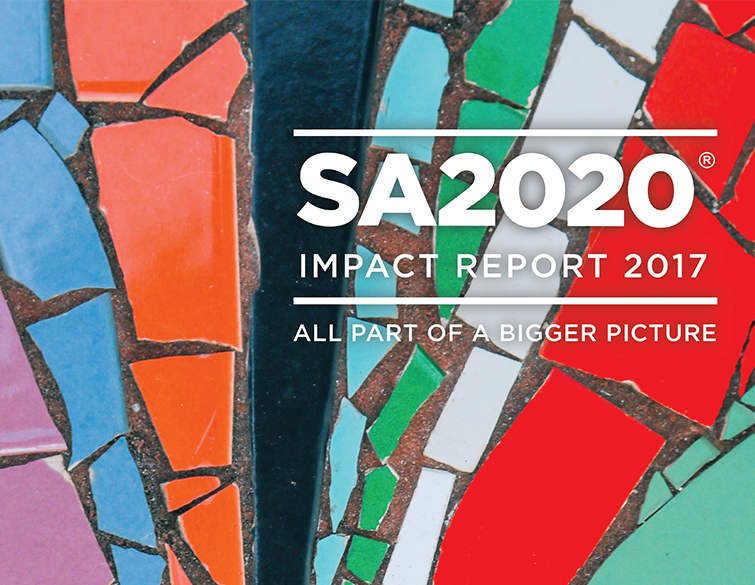I am often asked: “So…what do you do all day?”
“Do you look at data all day?”
“Isn’t SA2020 just a vision?”
“You do research, right?“
“Ohhh….I get it…y’all are like a think tank?”
So, here’s the answer: We are results-driven. We use the vision as a playbook for facilitating alignment towards those results. We do a lot of research because we believe results come from being data-informed. And we think a lot. We are naturally curious. And we encourage others to ask questions and be curious, too. Then…we work.

SA2020 – the nonprofit organization – believes in your vision. And we work every day to align efforts to create the biggest impact on that vision. We convene partners, we analyze information, we facilitate strategies, we activate and engage the community, we pivot when programs or efforts aren’t working to find better solutions, we connect, and, on occasion, we have fun. We believe that when we work together towards common goals, positive change happens. But we don’t just believe that…we prove it.
Our newest Impact Report, released on January 19th, shows some incredible momentum: 70% of our indicators are moving in the right direction. The data – which runs a bit behind, from 2014- 2017 – shows that 70% of the indicators are better now than they were when we started tracking them. But, and we’ll say it again and again, the conversation is bigger than just the indicators. To look at the indicators as merely moving up or down doesn’t tell the full story. And while we must remain true to the eleven original set of results, we want to keep getting better at painting a truer picture of our community. So this year, we’ve added some new indicators (part of a community conversation in partnership with the City of San Antonio’s Planning Department as part of the City of San Antonio’s SA Tomorrow Comprehensive Plan):
3. Decrease Housing Cost Burden
4. Eliminate Traffic Fatalities and Serious Injury

Above is a snapshot of all 61 indicators. Again, 70% are on track. Progress! And yet, we know there’s a bigger picture to consider. As you explore San Antonio’s progress, we ask you to keep asking questions:
• Why is this indicator important to the bigger picture?
• Which indicators may influence others?
• Why is an indicator moving in the right or wrong direction?
• What are the complete indicators telling us about our desired results?
• Who is most impacted by this indicator?
• What are potential solutions?
Here’s what we mean by the bigger picture: in Family Well-Being, the data show that our collective goal for decreasing child abuse and neglect has already been met. So…does that mean child abuse and neglect has decreased? Not necessarily. We measure this indicator through confirmed cases. A recent report by SA2020’s data partner, CI:Now, shows that this is “less about a decrease in abuse and neglect” and more about “the system’s ability to timely and appropriately address and confirm or rule out abuse/neglect.”

Here’s another example: San Antonio met our 2020 goal for increasing high school graduation rates within two years. That’s great news! But why did we prioritize high school graduation in the first place? It wasn’t just to check a goal off our list; it was to set up our students for great careers and successful lives. And when we look to everything after high school—college enrollment, college achievement, professional certificates—we see that the progress isn’t trending in the same direction.
And one more: our per capita income is another one of the 70% that’s moving in the right direction. We’re not quite on track to meet our goal in 2020, but we are making progress. But, if you break this down by City Council district—something we did in this year’s Impact Report for the first time—you’ll see discrepancies between different parts of town that don’t look much like progress. By disaggregating some of the SA2020 Community Indicators in this way, we can see where we, as a community, need to double down efforts, create targeted programs and policies, and distribute resources most effectively.
This is why we ask you to ask questions and look at the bigger picture. And when it starts to feel a little too big and overwhelming, we’re here to share with you small ways you can make incremental change yourself. That’s why we launched 300 Ways to Make an Impact, a super simple way to commit to 1 new action that will help move the needle on our shared goals. In return, we’ll send you a reminder and any other information that will help you accomplish it. Get started here!

So, what do we do all day?
1. We report on the progress toward our shared goals. To hold us all accountable to the vision we created.
2. We align efforts to make this vision a reality.
3. We inform and engage the public.
Because at SA2020 we believe that when we work together toward common goals, positive change happens. And we don’t just believe it—we prove it, too.

